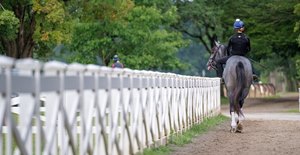No Fatal Breakdowns During Seven Months at Oklahoma


In the end, there was some rather uplifting news to come out of Saratoga Race Course.
While a rash of fatalities marred the 40-day race meet, at the famed Oklahoma training track there was news that was the polar opposite from the main racing surfaces at the iconic racetrack.
Through seven months of use and 9,164 timed workouts on dirt and turf at Oklahoma through its Nov. 11 closing, there were no fatal breakdowns on surfaces that were rebuilt and improved by the New York Racing Association in 2021 in order to handle the influx of horsemen stabled there during the spring and fall non-racing months.
"It is reassuring to see numbers like this given the high number of works there at Oklahoma. There were a lot of hoofprints on those surfaces. It was very satisfying for all of us," said Glen Kozak, NYRA's executive vice president of operations and capital projects. "Even with what we went through this summer at Saratoga, the feedback we got from trainers, jockeys and exercise riders was positive and these final numbers confirm it. The work we put in at Oklahoma was a very, very good investment."
During racing at the historic main racetrack there were nine equine deaths, three of them occurring on the dirt track. A year earlier, there were five fatal breakdowns at Oklahoma. But two years removed from a renovation project that was championed by trainer Chad Brown, there was a perfect record.
"I would say everyone who has trained at Saratoga would say it has been great to work on. Even the ones with concerns at first, I'd be surprised if they didn't feel differently now," said Brown, the four-time Eclipse Award winner who maintains a stable at Saratoga throughout the year. "Most trainers were on board once they understood the history of the track and what we were training on and what might happen if we don't fix it.
"You're happy to hear news like this about Oklahoma and it feels great that the renovations NYRA made have had a positive impact."
Racing has been taking place at Saratoga for 160 years. The Oklahoma training facility was opened circa 1900 and for much of the time since then there was roughly one month of racing at the facility.
In the last few decades, racing expanded to its current state of 40 days while the rise of stables with more than 100 horses led to Oklahoma getting drastically more use outside of the racing season. While much of the horse colony in the spring and fall consists of 2-year-olds, some trainers have also used Oklahoma as a fall base to prepare horses for the Breeders' Cup.
Trainer Bill Mott stabled Breeders' Cup winners and Horse of the Year candidates Cody's Wish and Elite Power at Oklahoma prior to sending them west to Santa Anita Park for the World Championships.
Yet all of that extended use from April to November also highlighted problems that Brown spotlighted such as poor drainage and the need for a wider track.
The main problem with the surface was the lack of an effective base for the track.
"The Oklahoma track had no real base and with the added activity and with the amount of horses stabled there, the track would get deeper with more usage," said Kozak, who acknowledged the key role Brown played in pushing for the improvements. "We could do things to tighten the track but without a base it was tough to get it as consistent as we needed."
Kozak's crew gave the dirt track a new base, creating a surface that mirrored the composition of the main racetracks at Saratoga and Aqueduct Racetrack as well as the Belmont Park training track. Aside from providing consistency for most of NYRA's surfaces, a new drainage system and a safety rail was installed. The track was widened by 10-15 feet in most areas to accommodate the added number of horses using the track.
"The key thing was getting consistent drainage," Kozak said. "People who used the track a lot noticed it dried out inconsistently because of the natural sand underneath it."
After a difficult summer of racing, the news about Oklahoma was welcomed by horsemen and seen as a reflection in the teamwork needed to produce a sterling safety rate.
"We always mention negative stuff and when we have good news like this, it is great to hear. It shows that what everyone is doing to make things safer is paying off," said trainer Christophe Clement, one of New York's top trainers who keeps a string of horses at Saratoga throughout the year. "We now have a wider and safer track at Oklahoma and to have a year without a fatal breakdown it reflects a combined effort by NYRA, the track crew, horsemen, the vets. Everyone worked together to make this happen and it's great to hear news like this."
